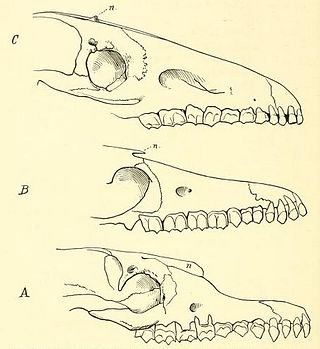
Litopterna is an extinct order of South American native ungulates that lived from the Paleocene to the end of the Pleistocene-early Holocene around 63 million-12,000 years ago, and were also present in Antarctica during the Eocene. They represent the second most diverse group of South American ungulates after Notoungulata. It is divided into nine families, with Proterotheriidae and Macraucheniidae being the most diverse and last surviving families.

Theosodon is an extinct genus of litoptern mammal from the Early to Middle Miocene of South America.

Protypotherium is an extinct genus of notoungulate mammals native to South America during the Oligocene and Miocene epochs. A number of closely related animals date back further, to the Eocene. Fossils of Protypotherium have been found in the Deseadan Fray Bentos Formation of Uruguay, Muyu Huasi and Nazareno Formations of Bolivia, Cura-Mallín and Río Frías Formations of Chile, and Santa Cruz, Salicas, Ituzaingó, Aisol, Cerro Azul, Cerro Bandera, Cerro Boleadoras, Chichinales, Sarmiento and Collón Curá Formations of Argentina.

Cramauchenia is an extinct genus of litoptern South American ungulate. Cramauchenia was named by Florentino Ameghino. The name has no literal translation. Instead, it is an anagram of the name of a related genus Macrauchenia. This genus was initially discovered in the Sarmiento Formation in the Chubut Province, in Argentina, and later it was found in the Chichinales Formation in the Río Negro Province and the Cerro Bandera Formation in Neuquén, also in Argentina, in sediments assigned to the SALMA Colhuehuapian, as well as the Agua de la Piedra Formation in Mendoza, in sediments dated to the Deseadan. In 1981 Soria made C. insolita a junior synonym of C. normalis. A specimen of C. normalis was described in 2010 from Cabeza Blanca in the Sarmiento Formation, in sediments assigned to the Deseadan SALMA.

Scalabrinitherium is an extinct genus of mammals of the family Macraucheniidae. Fossils of this animal were found among the fossils of prehistoric xenarthrans in the Ituzaingó Formation of Argentina.

Proterotheriidae is an extinct family of litoptern ungulates known from the Oligocene-Late Pleistocene of South America. Members of the group were small-medium sized cursorial herbivores with brachydont teeth, with their toes showing progressive reduction, with later members of the group bearing weight on a single large toe similar to living horses.

Neolicaphrium is an extinct genus of ungulate mammal belonging to the extinct order Litopterna. This animal lived from the Late Pliocene (Chapadmalalan) to the Late Pleistocene (Lujanian) in southern South America, being the last survivor of the family Proterotheriidae.
Proterotherium is an extinct genus of litoptern mammal of the family Proterotheriidae that lived during the Late Miocene of Argentina and Chile. Fossils of this genus have been found in the Ituzaingó Formation of Argentina, and the Galera Formation of Chile.
Promacrauchenia is an extinct genus of macraucheniids that lived during the Late Miocene to Late Pliocene epochs of what is now Argentina and Bolivia. It belongs to the subfamily Macraucheniinae, which also includes Huayqueriana, Macrauchenia, and Xenorhinotherium. Fossils of this genus have been found in the Ituzaingó, Andalhuala, and Cerro Azul Formations of Argentina.
Deuterotherium is an extinct genus of South American native ungulates, which lived during the Deseadan age of the Oligocene in what is now Argentina. Its type species is Deuterotherium distichum. It was named by Florentino Ameghino in 1895. The holotype of Deuterotherium distichum is a calcaneum. It was formerly identified as a proterotheriid litoptern. In 1999, Shockey argued Deuterotherium was certainly not a litoptern and interpreted it as a notohippid notoungulate. In research by Soria posthumously published in 2001, Soria considered Deuterotherium a nomen dubium.
Polymorphis is an extinct genus of litopterns belonging to the family Macraucheniidae. It lived during the Middle Eocene of Argentina.
Uruguayodon is an extinct genus of proterotheriid from the middle Pleistocene of Uruguay. It is known from the type and only species U. alius, named by Corona and colleagues in 2019 for dentaries and a partial postcrania from the Raigón Formation. Uruguayodon represents one of the latest occurrences of Proterotheriidae, with only Neolicaphrium representing other remains from the Pleistocene to possibly Holocene.
Proadiantus(Ameghino, 1897) is an extinct genus of adianthid litoptern. It lived during the Late Oligocene, in what is today South America. It consists of only 1 species, Proadiantus excavatus.

Anisolambda is an extinct genus of litoptern. It lived from the Late Paleocene to the Middle Eocene in what is now Argentina.
Proectocion is an extinct genus of adianthid litoptern. It lived during the Early Eocene, in what is now South America.

Protheosodon is an extinct genus of proterotheriid litoptern. It lived from the Late Oligocene to the Early Miocene in what is now Argentina and Colombia.
Prolicaphrium is an extinct genus of proterotheriid litoptern that lived during the Early Miocene, in what is now Argentina. Fossils have been found in the Sarmiento Formation of Argentina.
Lambdaconus is a genus of proterotheriid from the Late Oligocene to Early Miocene of Argentina. The type species is L. suinus, named in 1897 by Ameghino, with referred species including L. lacerum, named as Proterotherium lacerum in 1902 by Ameghino, and L. inaqeuifacies.

Paramacrauchenia is an extinct genus of proterotheriid litopterns from the Early Miocene of what is now Argentina and Chile. Its fossils have been found in the Sarmiento and Santa Cruz Formations of Argentina and Chile.
Guilielmofloweria is an extinct genus of proterotheriid litoptern that lived from the Middle to Late Eocene of what is now Argentina. Fossils have been found in the Sarmiento Formation of Argentina.



















